|
Monday, February 25, 2008
Progress Notes
We have a committee headed by Karen Smith devoted to organizing information about the
almost one hundred one room schools which were dispersed throughout the county before
consolidation occurred in the early 1950's. We encourage all our readers of this website
to send us information and photos about any of the one room schools they or family members
attended years ago. Already, we have collected a great deal of information and put it on
our web site at:
www.millercountymuseum.org/schools.html
Once in a while I will feature on this page one of these schools for which I have
received some extra or particularly interesting information, many times submitted by
someone who actually attended or taught at one of the schools. For example, a few weeks
ago, the Bear one room school was featured in a narrative written by Doris (Wright)
Clemens. Scroll down half way through the narrative on the following website to get to the
part about the Bear school:
www.millercountymuseum.org/071217.html
This week I would like to return to the Brown Road area located between Eldon and
Tuscumbia to feature the Ginger Ridge one room school (photo 01).
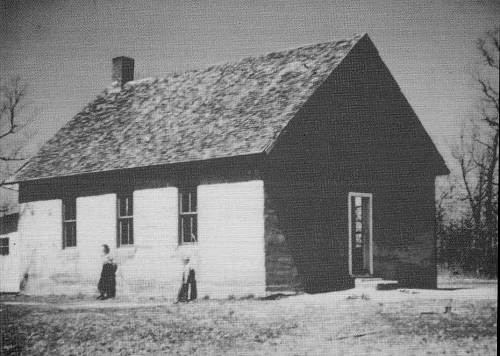 01 Ginger Ridge School The incentive to do so first was that I received a very well written narrative
about the school by Elmer Brown, who once was a student there. And the other reason was
that Ila Tucker Hill (photo 02), from
whose book, "Our Memories," I quoted a long passage a couple of weeks ago
concerning medical care in the first part of the last century, had with the help of her
children, put together a very complete summary of facts about the Ginger Ridge School.
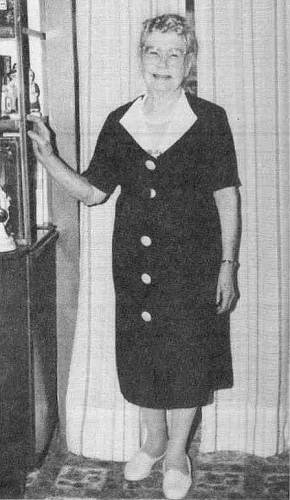 02 Ila Tucker Hill From the information she gathered she authored a very interesting book entitled,
"Our Little School House". The book includes numerous essays of memories written
by former students and teachers as well as good number photos of previous students and
teachers. A copy of Ila's book can be obtained from her son, David Hill for a nominal
charge. Below are David's address and email if you are interested in purchasing this book
or any of the other four books that Ila wrote:
David Hill
28149 NE 212th Ave
Battle Ground, WA 98604
Email: DavidHill@aol.com
Our website also has some information about the Ginger Ridge School at the following
web page:
www.millercountymuseum.org/schools/MCSS094.html
Elmer (Dub) Brown, who was raised on Brown road (and I have always assumed it was his
family name from where the name of the road was chosen), wrote his narrative and
commentary about several of the years he attended Ginger Ridge School including anecdotes
and commentary which I will copy here. First, though, I wanted to post a photo of Dub who
has been very helpful to us in supplying information about the Ginger Ridge area (photo 03). A second photo Dub sent me was
taken while he was vacationing in Alaska (photo
04).
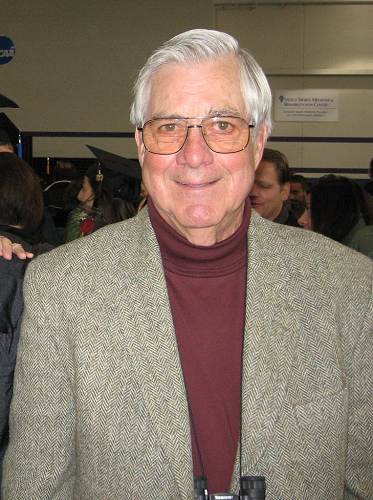 03 Elmer Brown
 04 Elmer on Train He has this to say about that trip:
"I was stationed in Alaska in 1969 to 1971 and at that
time, the Alaska Railroad was the only direct route between Anchorage and Fairbanks
(Raymond Graves and his wife spent many construction seasons in AK on road construction).
A highway route existed but it was almost twice as long as the train route. There was a
considerable amount of romanticism associated with getting on the train and being dropped
off at a point of your choosing out in the "bush". At some later time, you could
hike back to the tracks, flag down the next train and hop aboard. I had thought about it
over the years and decided that, should I ever get back to AK, I would make at least part
of that trip by rail. Granted, as you can see by the luxurious dome car surroundings, it
has been commercialized significantly since the early 70s, but I can remember that I was
reminiscing about my earlier time there, as I sat reading the paper and looking out at the
unspoiled wilderness."
Dub is one of those people who has a knack for writing in an interesting and engaging
style. I asked him what was the incentive which inspired him to record memories of his
early life in Miller County. This was his explanation:
"When I was a youngster growing up, I always enjoyed
hearing members of the family who were older than I, they all were, tell stories about
events that had occurred before I arrived on the scene. I particularly enjoyed hearing my
mother and Aunt Belle talk about their early life in Scotland. I have often regretted that
I did not take the time to write these stories down so they would not be lost.
With that in mind, I have decided to jot down as many of
these as I can remember as well as my recollections of my own experience. If no one ever
discovers them, or bothers to read them if they do, I won't be broken hearted. I will have
had fun doing it and there will have been little cost except a computer disk, a bit of
electricity, and some wear and tear on the computer. On the other hand, perhaps my typing
skills will be refreshed a bit.
At the moment I am thinking only of getting down various
isolated incidents and anecdotes. Perhaps as I do this some pattern for a larger endeavor
will emerge."
Now for Dub's narrative of his memories of Ginger Ridge School:
GINGER RIDGE
Ginger Ridge was the grammar school I attended through the
eighth grade. It was a one room facility located smack dab in the middle of the district.
This meant that those who lived near the perimeter had over a mile to walk and in some
cases nearly two since the district was three miles by three. This also meant that it was
better than a mile from the nearest maintained road since they all seemed to be located
along the perimeter. On occasion, if it wasn't too muddy or snowy, hardy souls would
venture to drive there in a car. Even with the high ground clearance of the cars in those
days it wasn't uncommon for them to get stuck in one of the many mud holes. Most
frequently it was reached by "Shanks Mare", a walk through the woods.
The building itself was rectangular with a normal gable
roof, a typical country school. The walls were poured concrete. I will always remember the
prominent crack in the front which extended from near the gable peak to the top of the
door. There was an iron rod with turnbuckle extending the width of the building which
apparently kept the walls from falling outward.
About two thirds of the way up, the concrete along the
crack had eroded to form a recess about six inches in diameter. One of our games was to
see who could throw a ball and make it stick in the hole. Then of course, we had to go ask
the teacher to let someone climb up into the attic to poke the ball through. As a boy, you
had really achieved "Big Kid" status when you were entrusted to make that climb.
The interior was rather Spartan, to say the least. Four
rows of double desks facing the teacher's table in the front. A globe, chalk boards on a
couple of walls and two books cases which housed the library and the supply of text books.
The only light available was what came in through the windows. We did have kerosene lamps
but they were only used in the event there was some sort of meeting or social event held
at night. The first couple of years I was there, heat was provided by a stove located in
the middle of the room with the pipe suspended by wires in its run to the flue at the back
end of the building.
Rest room facilities consisted of two "one
holers" located behind the school.
Drinking water was drawn from a well. The first year or so
I was there, this was accomplished by means of a bucket attached to a rope which ran over
a pulley. The bucket was a long cylinder with a one way valve in the bottom. This would
open as the bucket was lowered into the water allowing it to fill. As it was lifted, the
weight of the water kept it closed. A rod was attached to the valve. This was pulled,
opening the valve and allowing the water to empty into a bucket. It was always important
to make sure there was a knot tied in the end of the rope not attached to the bucket. More
than one well bucket has had to be fished out because the rope got away from the person
drawing water.
I thought drawing water was very exciting, especially
since we didn't have anything like this at home. I suspect part of the appeal was that
only the bigger kids were allowed to draw water. It took quite a bit of strength and
endurance to pull the weight of the bucket and three gallons of water almost a hundred
feet. I was always a little disappointed that they had installed a hand pump by the time I
got big enough to handle the bucket and rope.
The pump itself brought another challenge (photo 05). The
yoke that attached the handle to the pump body would break on occasion leaving the whole
thing inoperable.
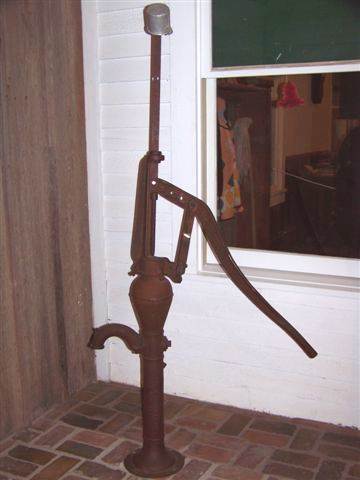 05 Well Pump Again, it was true "Big Boy" status to be
entrusted to walk the approximate four miles into Tuscumbia, get the piece welded and walk
back again. Though I don't remember how long it took, I do recall making the trip one
time, probably when I was in seventh or eighth grade. I'm sure that if mother had tried to
get me to do such a thing at home I would have found all sorts of excuses.
My teacher in first and second grade was Miss Beatrice
Biddle (group photo 06). She was a young woman in what I remember as being her first
teaching assignment. I think she had gone to college for two years at Central Missouri
State Teacher's College in Warrensburg. I don't remember a lot about her except that she
gave me the only whipping I ever received in school.
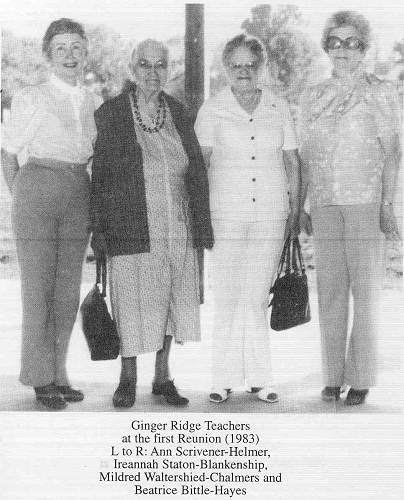 06 Ginger Ridge Teachers Fuel for the heating stove was wood which was always
delivered in the early fall and stacked in neat ricks along one side of the playground.
Harold Hill, Donny Simpson, Jared Thompson and I found this to be a wonderful building
material supply and spent many of our recesses and lunch hours constructing houses. The
firewood proved to be an excellent material for the walls and there were a number of
planks and pieces of sheet metal lying around which made adequate roofing material. There
were many oak trees on the grounds and a thick bed of their leaves served as a floor to
keep us from feeling the cold ground.
Three of us were playing in one of our houses one day when
the urge to go to the bathroom hit. Since we were on the other side of the grounds from
the toilet and since we commonly went wherever we happened to be when we were in the
woods, we thought nothing of going over behind a rick of firewood and doing our thing. I
can't remember if we were particularly concerned about being seen or not but at any rate
we were. Lyman Meyers, a boy about two years older than us, and one of my particular
tormentors, ran gleefully to the teacher and reported us. We were called in and the paddle
was applied. All the other students, probably about 30, were told to stay outside, but of
course they knew what was going on and probably were looking in the windows and listening
at the door.
Getting the whipping was bad enough. The humiliation was
worse than the physical pain because we were subject to considerable ridicule from the
other students. My worst fear though, was that my mother would find out about it. She
believed strongly in backing the teacher in disciplinary matters and I had been promised
in no uncertain terms when I started school that for every whipping I got at school there
was another one waiting for me at home.
It didn't take long. Naturally, I didn't say anything
about it at home that night. However, my sisters Kathleen and Marie still lived there and
rode to work with the Meyers kids' mother. The next evening at the supper table they
started inquiring if anything had happened at school recently that I wanted to talk about.
I can still remember the sinking feeling in the pit of my stomach. I tried to bluff it
through, but of course, was unsuccessful. I don't remember if I received the promised
whipping from Mother or not but the ordeal of being found out was bad enough.
When I reached third grade, progress or greater
enrollment, I was never sure which, dictated that we would have two rooms and two
teachers. This was accomplished by installing a new heating plant in one corner of the
building and a plywood partition on tracks down the middle of the building. The sections
of this partition could be slid out to open the room up for social events such as pie
supper and play. My teacher in third and fourth grade was Mrs. Henry (Lois) Thompson. I
fell madly in love with her. The facts that she had a husband and a small son with another
baby on the way didn't deter me one bit. As was not uncommon in those days, she boarded
with one of the district families, in this case the Oscar Hill family. It just happened
that they lived along my route to school. You can bet I was never tardy. I made sure to be
there early enough to walk to school with Mrs. Thompson.
At the end of two years, either because enrollment had
dropped or due to the shortage of teachers caused by World War II, we reverted to one
teacher. It turned out to be Mrs. Lulu Farmer who lived with her husband John on one of
the larger farms in the district.
Mrs. Farmer was a small woman in her early sixties with
snow-white hair and snapping dark eyes. She and my mother were good friends which turned
out to be both a blessing and a curse; a blessing in that she was a known quantity but a
curse in that I was sure any misbehavior on my part would be reported directly to my
mother. To the best of my recollection that never happened though I'm sure there were
opportunities. She had her own ideas about what should be taught in school and since she
was partial to woodworking and nature study, I learned a lot more about small project
carpentry, trees, birds and other wildlife than I did English and Arithmetic. In fact,
when I got to high school and first encountered the parts of speech, I panicked. I spent
several evenings with Frieda Hill, a neighbor girl who was three years ahead of me,
getting a crash course in diagramming sentences.
Like the rest of us Mrs. Farmer walked to school. It
seemed that though it was rain or shine, blizzard or drought, she always wore
"gum" boots to and from school. As I look back, it made perfect sense a good
share of the time. She had to cross several creeks in the mile and a half she had to
cover. But we kids thought it was strange behavior and made fun of her behind her back.
One thing no one ever made fun of was her ability as a
cook. And especially her angel food cake! She had a reputation throughout the area as the
best at that particular product. Like all kids, I had a sweet tooth. There was never a
shortage of pies, cakes and cookies at our house but angel food was a rarity. My mother
could not see the sense of wasting the whites of a dozen eggs on a cake and then feeding
the yolks to the hogs. That dozen eggs represented a cash income of probably fifty cents,
which to us in those days was a lot of money. So, anytime the Farmers were coming for
Sunday dinner or we were going to their house I was always hopeful that Mrs. Farmer would
produce a cake.
The teacher my eighth grade year was Mrs. Charles (Leola)
Slote, another resident of the district. It was 1944, the last year of WW II and most of
the qualified teachers were in the military or making lots more money working in defense
industry. It was her first year of teaching and the fact that her little girl was a first
grader complicated her job because her daughter, naturally, didn't understand that mom had
to be in a different role while at school. The state had granted emergency certifications
to a number of people in order to keep the schools open because there was no other option.
Mrs. Slote continued with her education and taught for several more years being regarded
as a respected and admired teacher.
A few years after I graduated, Ginger Ridge went the way
of most one-room country schools. It fell victim to consolidation. This did not occur
easily. There were a number of people in the district who felt that the one room school
had been good enough for them and therefore it was good enough for their kids. Bert Hill,
our next-door neighbor, was on the school board at the time and was very outspoken in this
particular belief. My mother was just as strong in her belief that consolidation would
result in better education for the children. Neighborly relations were a bit strained for
a while.
The building was sold and converted into a residence,
which has been inhabited off and on during the years. David Hill, Bert's youngest son, now
owns it. I'm not sure what he had in mind when he bought the place for he lives somewhere
in the state of Washington. I know that in the summer of 1996 he and his mother, Ila, who
at a very spry 96, organized a reunion of all who had ever had any association with the
place. Unfortunately, for a variety of reasons, I was not able to attend.
(Note: The reason David bought the school when it came on the market is very
interesting and is recounted in David's narrative about his experience at the school as a
child which is included as part of Ila's book. I mention this as a teaser to encourage the
readers of this website to purchase the book from David, whose address is listed above.
You won't be sorry. David is a very good writer).
When my family and I visited Mother and Marie over the
years we would often walk through the woods to the school. My kids would always tease me
about walking three miles, up hill in both directions and through the deep snow but I
don't think they ever got the full flavor of the place. However, I never took that hike
but what I was transformed back through time and felt the presence of those people I had
known there.
Thanks Dub.
One interesting thing about the old one room schools was not only that the teachers set
discipline rules for students which were very strict but that the teachers themselves were
expected to follow strict standards as well. I became aware of this custom some time ago
when I was reading the minutes of one of the meetings of the Hickory Point School recorded
in the very early part of the last century in which the behavior expected of teachers was
well defined and restrictive. The following is a compilation of some of the rules and
duties teachers had to follow in those early days which commonly were imposed not just in
Miller County but in general in rural America. I copied these rules from a list that was
on display in the Henry County Museum:
1. Teachers each day will fill lamps and clean chimneys.
2. Each teacher will bring a bucket of water and a scuttle of coal for the day's
session.
3. Make your pens carefully. You may whittle nibs to the individual taste of the
pupils.
4. Men teachers may take one evening each week for courting purposes, or two evenings a
week if they go to church regularly.
5. After ten hours in school, the teachers may spend the remaining time reading the
Bible or other good books.
6. Women teachers who marry or engage in unseemly conduct will be dismissed.
7. Every teacher should lay aside from each day's pay a goodly sum of his earnings for
his benefit during his declining years so that he will not become a burden on society.
8. Any teacher who smokes, uses liquor in any form, frequents pool or public halls, or
gets shaved in a barber shop will give good reason to suspect his worth, intention,
integrity and honesty.
9. The teacher who performs his labor faithfully and without fault for five years will
be given an increase of twenty-five cents per week in his pay, providing the Board of
Education approves.
I also saw one school board record of minutes which required a teacher to resign if she
became pregnant. I think this rule may have lasted quite a while extending even into more
recent times according to my sister-in-law, Sharon Holder, who taught third grade at Eldon
for many years.
I was sad to learn of the fire which destroyed the historic Nixdorf home in Ulman last
week (photo 07).
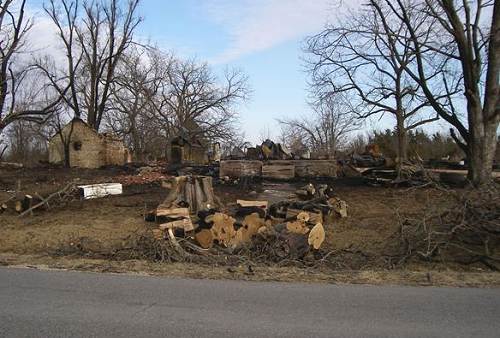 07 Nixdorf Home - 19 Feb. 2008 Mrs. Herbert Nixdorf and her son, James, were living in the home once owned by
Dr. A.P. Nixdorf (photo 08), one of
the first physicians in Miller County, and the home has remained in the Nixdorf family for
almost a hundred years.
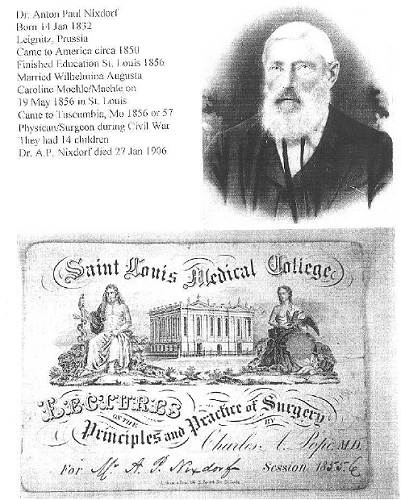 08 A.P. Nixdorf M.D. Picture and Certificate Click on image for larger PDF formatted file My great great uncle Simeon Bear bought the house in 1908 maybe from William
Coburn who had built it in 1871. After Simeon's death, my great grandfather, David C.
Bear, who was a brother of Simeon, bought the house in 1919 from Simeon's heirs and lived
in it until about 1925 when he sold it to Dr. Nixdorf. I have two photos of the home from
my family's collection but I am not sure of the dates although the photo with the car
would indicate that particular photo was taken in the 1970's (photo 09 and photo
10).
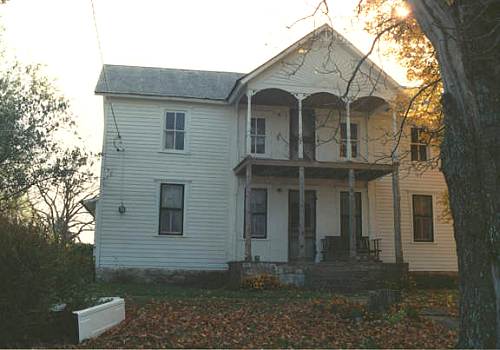 09 Nixdorf House Hotel
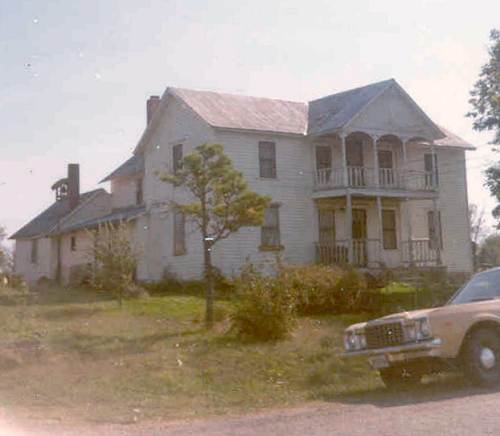 10 Nixdorf Home - 1970's Attached is a narrative of the history of the home written several years ago by
Roger Dillon for a publication of the Lake of the Ozarks Council of Local Governments
Historical Preservation Program (photo 11 of
article).
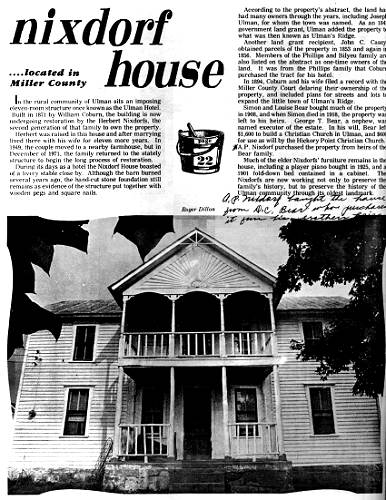 11 Nixdorf Bear House Click on image for larger PDF formated file At the time of this writing I haven't read a newspaper account of the fire, but
neighbors told me that Mrs. Nixdorf suffered smoke inhalation and was hospitalized for a
while. The family lost all their possessions in the fire. They are members of the Ulman
Christian Church where donations can be sent in their name.
We were pleased to meet this last week with representatives of York Cemetery Services,
Wayne York and Clancy Boots (Company phone number: 573 291-0254), for the purpose of
having some old tombstones rehabilitated (photo
12).
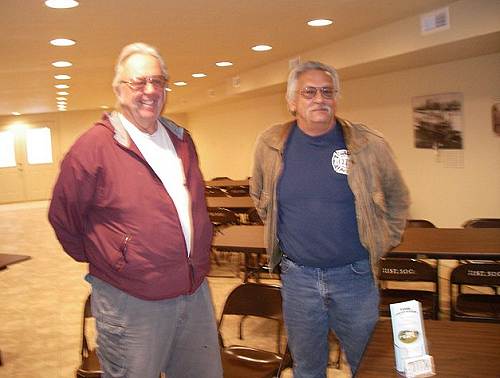 12 Wayne York and Clancy Boots Accompanying Wayne York was Clancy Boots who originally was from the Old Bagnell
area. These gentlemen are experts in restoring old tombstones and we are grateful to have
had the opportunity to consult with them about our particular needs. I enjoyed talking
with Clancy about Old Bagnell; the Boots family were some of the original residents of the
area. Clancy's grandfather at one time was town marshal during the building of the dam.
Last week the Miller County Historical Society held its monthly meeting in the
multifunction area of the lower floor of the new addition (photo 13).
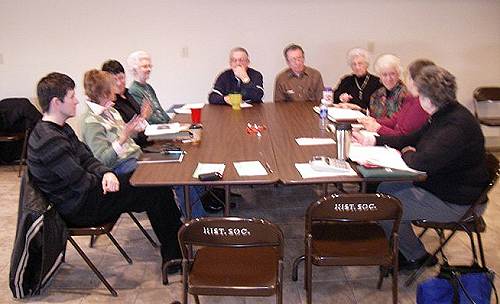 13 MCHS Board - 20 Feb. 2008 Left to right going around the table are Joe Cochran, Donna Carrender, Judy
Pryor, Wanda Wright, Carl McDonald, Jim Clark, Helen Schulte, Peggy Hake, Nancy Thompson,
and Betty Kallenbach. One of the most exciting items discussed were the plans for the
ongoing renovation of the original museum area of the old Anchor Mill Hardware store. Work
has progressed such that we now have most of the wiring placed for new lighting and the
dry wall and insulation is going to be installed next week. Architectural plans have been
completed as to the layout and design of the seven model rooms which will represent
historically accurate types of homes and stores of the county one hundred years ago.
That’s all for this week.
| 


